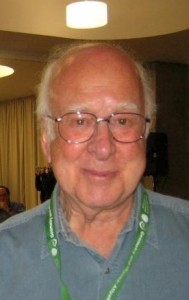
Peter Higgs is best known for his theory explaining the origin of mass of elementary particles in general and the Higgs boson in particular. (Photo: Gert-Martin Greuel via Wikipedia Commons)
Scientists might be zeroing in on just where the Higgs boson – the hypothetical sub-atomic particle believed to be a building block of the universe – may be hiding.
Many expected CERN scientists to announce the discovery of the mysterious Higgs boson at a Dec. 13 seminar. Observers didn’t hear what they had hoped to hear. Instead they were told that, while scientists are seeing hints of the Higgs boson, they haven’t actually found it yet.
The status of two experiments (Atlas and CMS) – tasked with finding the Higgs boson, if it exists – was announced at CERN headquarters in Geneva, Switzerland Tuesday.
The results so far indicate that, while they’ve made significant progress in the search for the hypothetical sub-atomic particle, they haven’t found enough evidence to conclusively rule whether or not Higgs exists.
While tantalizing hints have been seen in both experiments, they’re not strong enough to claim a discovery.
CERN says the analysis of both experiments will be refined in the coming months.
However, a definitive statement on the existence or non-existence of the Higgs will require more data, and is not likely until later in 2012.
NASA scientists want to get a sample of a speeding comet as it makes its way through the inner solar system.
To get their sample, the researchers plan to send a spacecraft to rendezvous with a comet, then fire a harpoon which would take rapid samples with surgical precision from specific locations, all while hovering above the target.
Using, what they call, the “standoff” technique would allow scientists to gather samples even from areas that are too rugged or dangerous to permit the landing and safe operation of a spacecraft.
“One of the most inspiring reasons to go through the trouble and expense of collecting a comet sample is to get a look at the ‘primordial ooze’ – biomolecules in comets that may have assisted the origin of life,” said NASA Goddard‘s Donald Wegel, the lead engineer on the project.
Comets are frozen chunks of ice and dust left over from the formation of our Solar System. As such, the scientists want to take a closer look for clues to the origin of planets and ultimately, ourselves.
Was Darwin wrong about emotions?
Researchers in Massachusetts are studying the link between emotions and facial expressions.
According to their research, people don’t all have the same set of biologically basic emotions.
And those emotions are not automatically expressed on the faces of those around us, contrary to what many psychological scientists think today.
A commonly-held belief by scientists is that certain facial expressions have evolved over time to express certain mental states and prepare our bodies to react in certain ways to certain situations.
For example, there’s the belief that widening your eyes when you’re scared might help you take in more information about the scene, while at the same time signaling to people around you that something dangerous is happening.
But lead author Lisa Feldman, of Northeastern University, says expressions are not inborn emotional signals that are automatically expressed on the face.
The theory that emotional expressions evolved for specific functions is normally attributed to Charles Darwin, in his book “The Expression of the Emotions in Man and Animals.”
Cholesterol-reducing drugs may do more
Cholesterol-lowering drugs called statins not only lower cholesterol levels, but also promote the breakdown of plaque in the arteries, according to researchers at New York University’s Langone Medical Center.
That gives hope to people with atherosclerosis, also called hardening of the arteries.
Up until this study, the researchers say that it was not fully understood how these statin medications could reduce atherosclerosis, which is the accumulation of fat and cholesterol in the bloodstream which eventually hardens into plaque in the arteries.
In time, plaque builds up along the walls of the arteries, causing them to narrow, reducing the blood flow. Blood clots can then form, or bits of the plaque can break off, causing blockages in the vessels which can lead to a potentially fatal heart attack or stroke.
Dr. Edward Fisher, co-author of the study, says, “Our new research shows statins actually promote the regression of atherosclerosis by altering the expression of a specific cell surface receptor within plaque cells. This molecular phenomenon helps dissolve plaque by expelling coronary artery disease-causing cells from the plaque lining the arteries.”






















Let me tell you why it is not possible for Higgs boson to be there, because there cannot be any fields in a realistic understanding of the natural world. Fields were devised in the times of Maxwell to comprehend pre quantum phenomena. Every event has to have a particle/wave explanation, no field would fill in the details where a postulation is weak. It’s a non quantum sub ev world out there. Gravitation and mass are due to a very different form of particle or particles, no resemblance with Higgs. Look for DCE research in Sweden, if you want to see the shape of the things to come. Eventually STR will be marginalized and space and mass will be seen as interchangeable.
Then you cannot even remove liquid helium from the LHC tunnel and talk of removing water from the pond, then your pond is full of magnetic fields and the distortions that the Earth’s gravitation brings to the surrounding space. The physical world is much more complex than a number of particles put together like bricks to define it’s existence. A copper atom sized Higgs boson is as laughable as the Earth centred universe of the Ptolemic construct. The Church and its professional scientists spent centuries to not only defend it but to take it to greater mathematical heights before finally crashing.
Finally, faster than light Neutrinoes and Higgs both cannot coexist — either one has to be wrong. It’s DCE research and superluminal speed which has the potential of breaking current scientific barriers, rather than finding a nebulous statistical dual peak for a Higgs, which well could be due to many other anomalies, one that LHC could not decipher is that of the UFOs.
Hey Rick. OK, geek joke, one colleague to another:
A Higgs Boson walks up to a Catholic church and is stopped at the door.
“I’m sorry, sir, but you can’t go in there.”
“Are you kidding? You can’t have mass without me!”
-Doug Bernard